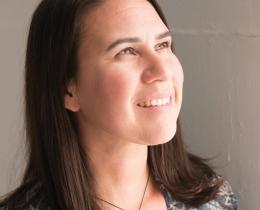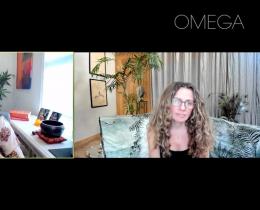Omega: How did you come to find yoga and yoga service?
Kathryn: I was a naval helicopter pilot and I fell while I was on deployment. Going through the medical separation process [leaving the military for medical reasons] was pretty tumultuous. My physical therapist recommended I incorporate yoga into my physical therapy because I lost all the feeling in my leg due to the injury and subsequent surgeries.
I started practicing yoga and while I was on my mat, I experienced "no thought." This was really helpful in my recovery, because I was stressed about what was going to happen now that I was out of the military. Yoga really helped me.
In the last six months of my active duty service, my squadron allowed me to be stationed in the same location as my husband. At the time, he was in Hawaii and I was in Florida. So, I moved to Hawaii and started practicing yoga more regularly, then joined a teacher training through the Yoga School of Kailua and the Hawaii Yoga Prison Project. Part of my teacher training was karma yoga. I started to teach in the prisons on the island of Oahu, and I found that they were experiencing the same healing and positive aspects of yoga that I had experienced.
When I moved back to Florida, I started my own organization, Yoga 4 Change (Y4C), which brings yoga to veterans, incarcerated men and women, vulnerable youth, and individuals suffering from substance abuse. I’m giving back to the community because of what yoga has done for me. In 2016, we taught over 20,000 people techniques to heal themselves and heal through their trauma. We teach about 21 classes every week.
Omega: How do you take care of yourself so you can continue to serve so many others?
Kathryn: Self-care is a really big component for me. We talk a lot about self-care as part of our teacher trainings because we are doing work that can be exhausting for individuals—serving individuals who have gone through trauma and working with kids who are in poverty. I have an eight-month-old and I’m running Y4C, and giving time to the Yoga Service Council, so it’s a lot that I'm giving. I found that taking yoga classes just for myself or doing yoga practice or taking some time and saying what I need has really helped me be able to sustain in this work.
Omega: What do you think is the biggest challenge to introducing vulnerable populations to yoga?
Kathryn: People have a misconception of what yoga is. When I say the word “yoga,” I have a vision of what it is, you have a vision of what it is, and somebody else who has never experienced it has a vision of what it is. Many imagine a skinny person doing perfect poses on a beach. That’s not yoga at all.
We educate our students on how to implement yoga into everyday life. We do this by talking about real world, real-life examples and breathing techniques and how they can apply them to their lives. We ask them to really explore what’s going on in their own body. When they’re stressed out or when they get into a fight with their partner, they can learn how to incorporate yoga poses or these breathing techniques to calm their own body as opposed to lashing out or reaching for a pill, a drink, or a drug.
When we’re training to go into facilities that have no idea what yoga is, there's a lot of education that goes into it. This has been the biggest hurdle, but it's also been the biggest awakening. Because once someone comes into the room who just got into a fight in a correctional system, for an example, once we can get them breathing and settled, then it’s like, “Okay. This is yoga. It’s not about the perfect warrior pose.” It's about calming their own body. It takes a little bit of education, but once you get personal buy-in, then they're doing the work. And you keep giving students options and examples of how to incorporate it.
Omega: How do the principles of yoga service apply to the different populations you work with? Are there different aspects that you focus on depending on the community you're working with?
Kathryn: The languaging might be different, in terms of the way that you describe a pose for example, but the principles are the same. Maybe the yoga forms that you would offer would be a little different. You might want to do a little bit more high intensity for one of the populations. And that’s what makes Y4C unique because we have teachers qualified in different types of yoga, and we're able to implement that type of yoga to those specific populations as opposed to assuming one size fits all. Yoga service is all about continually meeting the students where they are. We might create something a little bit different based on body type and ability. We are not assuming everyone can do this pose or everyone can understand this lesson. We allow them to feel empowered throughout the practice, and that’s what we’re really focused on.
Omega: Can you talk specifically about the community aspect of yoga service and how that has impacted your life?
Kathryn: It’s easy to think you’re in your own little silo in your own little world doing your own little thing. And what’s great about the yoga service community is that when we all come together, we’re able to be authentic about what’s going on. We can talk about the real-life problems, because typically, everyone's having the same sort of issues, whether it's about how to get funding or how to obtain supplies or get more powerful yoga teachers.
What I love about the yoga service community is that you don't have to pretend. You can be honest. The more people that are collaborating, the more students are impacted positively. At the same time, it’s great because when I offer my mistake, somebody else at the table has made that mistake or somebody has a new way of looking at it because they’re not in my little silo.
Omega: How can someone who is inspired by the work that you’ve done get started in their own community? What advice or tips would you have for them?
Kathryn: Ask questions. Don't assume. Hang on. Ask more questions. Ask for advice. Seek feedback. Try not to make the same mistake that someone else has made. The only way you do that is by reaching out. Connect with people that you respect so you can learn from them and learn with them and maybe eventually collaborate with them. It seems like the more we can all work together, the greater impact we’ll have.
If you get told “no,” just move on to the next thing. I've applied for probably over 200 grants and I’ve receive two. But I’ve learned and that’s so important. I’ve learned why I haven't gotten the grants, and how to write better grants, and found ways to make my program better. So, “no's” are gifts, honestly.
I love going to trainings and connecting with people at conferences like the Yoga Service Conference. The more you’re learning, the more your students will learn—it's better for everybody. I know it can be expensive for a yoga teacher to come to a conference. At the same time, the reward is way above that. Even just meeting two people would be huge because that's what happened to me. I went up to two random people and I said, “Let's be friends because I’ve read all your books and done all your tapes and I respect you so much.”








